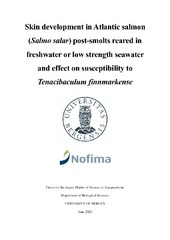| dc.contributor.author | Fredriksen, Marte | |
| dc.date.accessioned | 2020-06-24T05:33:45Z | |
| dc.date.available | 2020-06-24T05:33:45Z | |
| dc.date.issued | 2020-06-24 | |
| dc.date.submitted | 2020-06-23T22:00:32Z | |
| dc.identifier.uri | https://hdl.handle.net/1956/22849 | |
| dc.description.abstract | Ulcer development caused by bacterial infections in the sea is a large problem in the Norwegian salmon farming industry, leading to increased mortalities, reduced fish welfare, down-classification at harvest, and increased use of antibacterial drugs. In recent years, infection with Tenacibaculum finnmarkense has been an increasing problem. Tenacibaculosis affects farmed salmon of all sizes but especially post-smolts in the first period after sea transfer. The transition of smolts from land-based facilities to seawater net-pens is challenging as the period after smoltification shows signs of temporary immune suppression. This study investigated if rearing conditions affect the barrier functions of Atlantic salmon (Salmo salar) skin and susceptibility of infection with T. finnmarkense. The goal was to histologically characterize any structural differences in the skin of fish reared at two salinities that could explain any differences in mortalities and the prevalence of the bacterium within challenged groups. This study showed that the skin is affected by the degree of salinity in the post-smolt phase. The skin of fish reared in freshwater (0 ppt) developed differently compared to the fish reared in low strength seawater (26 ppt). Also, the skin surface of freshwater fish was poorer compared to brackish water fish three days post challenge, suggesting skin of fish without seawater adaptation to be more affected when transferred to seawater. Results from gene expression analysis indicate significantly stress in the outer skin layers, and the presence of T. finnmarkense in the skin is reflected in the up-regulation of several immune-related genes. Although differences between rearing conditions were confirmed in this study, no structural differences that would explain why adapting smolts to seawater before sea transfer seem beneficial were identified. Therefore, more research on this topic is needed. | en_US |
| dc.language.iso | eng | |
| dc.publisher | The University of Bergen | en_US |
| dc.rights | Copyright the Author. All rights reserved | |
| dc.subject | salinity | |
| dc.subject | tenacibaculosis | |
| dc.subject | challenge experiment | |
| dc.subject | histology | |
| dc.subject | gene expression | |
| dc.subject | skin disease | |
| dc.subject | Tenacibaculum finnmarkense | |
| dc.subject | Atlantic salmon | |
| dc.title | Skin development in Atlantic salmon (Salmo salar) post-smolts reared in freshwater or low strength seawater and effect on susceptibility to Tenacibaculum finnmarkense | |
| dc.type | Master thesis | |
| dc.date.updated | 2020-06-23T22:00:32Z | |
| dc.rights.holder | Copyright the Author. All rights reserved | en_US |
| dc.description.degree | Masteroppgave i fiskehelse | en_US |
| dc.description.localcode | FISK399 | |
| dc.description.localcode | MAMN-FISK | |
| dc.subject.nus | 759906 | |
| fs.subjectcode | FISK399 | |
| fs.unitcode | 12-60-0 | |
